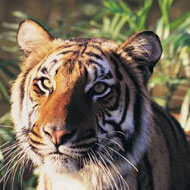
Increase thanks to conservation efforts
The number of endangered tigers in Nepal has almost doubled in three years, according to figures released by the Zoological Society London (ZSL).
Survey findings show that since ZSL and its partners began conservation work in 2014, Bengal tiger numbers in the Chitwan-Parsa Tiger Complex have risen by almost 90 per cent.
Wild tiger numbers in Nepal had been shrinking, on-the-whole due to poaching for the illegal wildlife trade.
ZSL's conservation programmes director, Professor Jonathan Baillie, puts the rise down to viable habitats, stringent protection, effective monitoring, and community engagement.
"When those conditions are in place, tiger numbers will flourish as Parsa has demonstrated very clearly," he said.
The Chitwan-Parsa complex - made up of the Chitwan National Park and the Parsa Wildlife Reserve - is one of the highest priority landscapes for conservation in Nepal.
In 2014, ZSL joined forces with Panthera, the global wild cat organisation, to monitor tigers and their prey in the area.
The organisations also set out to provide training for effective law enforcement and the use of the SMART system - a computer programme that is said to improve the effectiveness of wildlife patrols.
"The impressive doubling of tigers in Parsa, and the almost unprecedented speed of this recovery is the testament to how law enforcement and strong government leadership can help save the species," said Dr. John Goodrich, Panthera's senior tiger program director.
ZSL and Panthera now aim to expand their conservation efforts to three other protected areas in the lowlands of Nepal.



 BSAVA is to partner with BVA Live (11-12 June 2026) to champion clinical research.
BSAVA is to partner with BVA Live (11-12 June 2026) to champion clinical research.